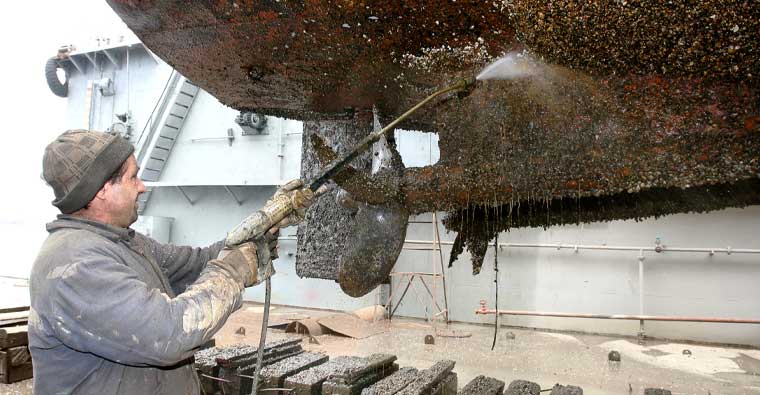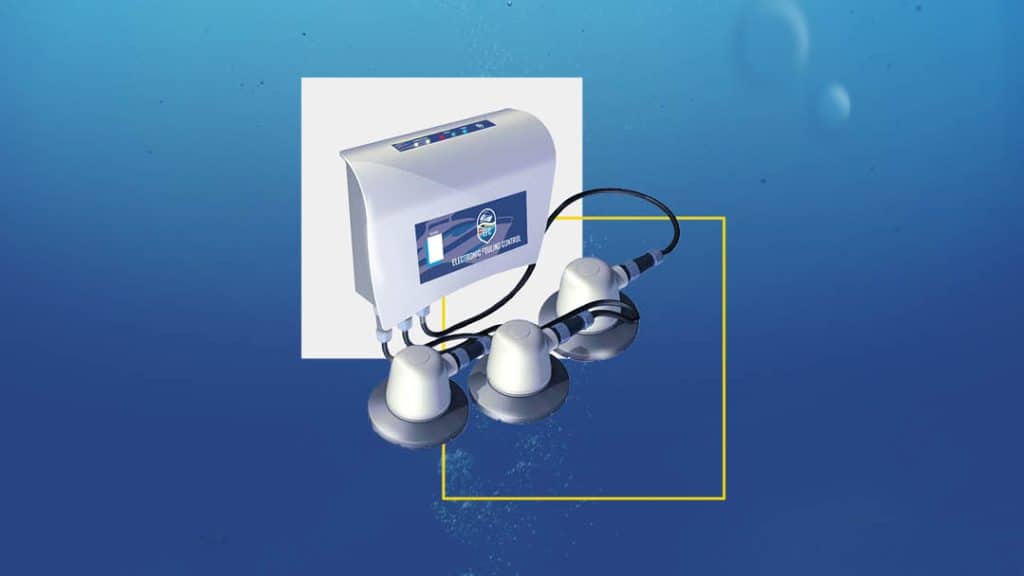Reapplying antifouling paint on an annual basis is the bane of every boat owner’s existence but is there a quicker and easier option for you that still helps to prevent barnacles and other marine fouling from attaching to your hull? Let’s have a look at the work involved in applying new antifouling paint first.
The traditional method – applying new antifouling paint
The annual (or sometimes more regular) job of reapplying new antifouling paint is certainly a job that’s not for the feint hearted. Many boat owners decide to use this method themselves to save a costly bill but there is a lot of work and hazards involved. An extensive guide to DIY antifouling can be found on our blog, but here is a quick run through of what to expect.
Getting a completely clean hull
First of all you need a clean hull to ensure the new antifouling paint sticks. For this many opt for a pressure washed hull to remove some of the fouling and any dirt and grime that may prevent paint from sticking, especially if the boat has been in the water for a long period of time.
Sanding the existing coating
Before applying new antifouling you need to sand down the existing antifouling. For this you need all the correct personal protective equipment before you get started as the dust from the old paint is extremely hazardous, not only to your health but to the environment, people and animals around you.
You must also look into local regulations regarding how to collect and dispose of antifouling dust and excess antifouling paint.
Applying all the paint correctly
Not only do you need to decide which is the most appropriate antifouling paint for your needs (hard antifouling or ablative, you can read our blog on the types of antifouling to help you decide) but how much antifouling paint you will need to cover your boat and which, if any, type of paint is already being used on the hull. Buying too much not only leaves you out of pocket but also means you have the task of disposing of this excess responsibly.
How many coats will you need? Well, that depends on the type and make of paint but it is likely you will need at least two coats, more on leading edges and areas around the waterline which experience more wear on the paint surface. It is best to read the instructions on any antifouling paint and follow them as closely as possible. You may also need a barrier coat and/or suitable primer as a tie coat in order to get a smooth finish and antifouling coat that lasts.
If this wasn’t tricky enough you need to make sure you choose dry weather to apply antifouling to ensure the paint dries effectively.
The issue with antifouling paints
Aside from the huge chore that applying them annually creates there is another key reason to swerve the use of antifouling paints this year.
That is the effect of the biocides they contain on the marine ecosystem. As well as killing off algae and other microscopic marine life, the biocides contained in the paint accumulate in the food chain affecting larger fish and marine mammals as well as us humans who eat them. You can read more about the effects of antifouling paints on the marine environment in our previous blog.
Easy antifouling option 1: Do nothing!
Your first option is for a completely bare hull and completely forego the antifouling paint on your boat to save you all that time and fuss but this method certainly has its downsides.
Allowing the build up of marine growth on the hull of your boat will reduce its performance, increase fuel consumption (therefore costing you more money to run your boat) as well as increasing the likelihood of invasive species hitching a ride and wreaking havoc wherever you decide to take them and leaving your boat looking pretty un-loved.
Some people decide to clean their boats more regularly to counteract this, but there are restrictions on in-water boat cleaning in certain areas so be sure to know your local authority rules before you begin.
Easy antifouling option 2: Ultrasonic antifouling for quick and simple antifouling
Your second option comes in the form of ultrasonic antifouling.
Ultrasonic antifouling works by using transducers attached to the inside of the bilge areas to transmit signals to the hull. These are very easy to install as they require no through-hull drilling and emit ultrasonic sound waves through their connection to the control unit that is linked to a battery power source or solar power unit or via an AC shore power line.
These ultra high frequency waves emitted by the transducers cause a slight vibration through the hull, creating micro currents that protect smaller marine life from attaching. By preventing the attachment of algae and other microscopic bio fouling, larger marine fouling such as mussels and barnacles are unable to adhere and so are no longer a problem.
How does the cost of ultrasonic antifouling compare with traditional antifouling?
The initial outlay of ultrasonic antifouling may be higher but the time, effort and money saved over subsequent years means that ultrasonic antifouling isn’t just the quickest and easiest antifouling option but also works out to be money saving in the long run.
Ultrasonic fouling doesn’t require the boat to be moving to work either, the transducers emit their signals around the clock to prevent the build up of marine fouling even when your boat is not in use. The solar powered options offered alongside our ultrasonic antifouling kits mean reduced running costs too.
Finally there is no need to dry dock your vessel in order to fit the transducers, this can all be done whilst the vessel is afloat if needs be.
What maintenance is there with ultrasonic antifouling?
Once installed there is very little maintenance to be done and certainly no annual backbreaking task of sanding down and reapplying antifouling paint, meaning more time enjoying your boat and less time maintaining it. We do suggest that you still use a suitable protective coating for your hull alongside the ultrasonic antifouling. This can help to prevent any corrosion of metal hulls or osmosis in glass reinforced plastic (GRP) hulls increasing the lifespan of your vessel. We highly recommend using a non-biocidal paint to preserve the environmentally friendly credentials of the ultrasonic antifouling.
Aside from a protective coating and hull cleaning there really is no other maintenance required on your boat hull with ultrasonic antifouling – it couldn’t be simpler or faster, especially compared to traditional antifouling! It sounds to good to be true but it really isn’t. You can read more about whether ultrasonic antifouling is suitable for your boat and hull type in our previous blog.
If you are interested in swapping to the quickest and easiest antifouling method around then check out our product brochure or speak to one of our knowledgeable team to decide which product is best for your vessel.




